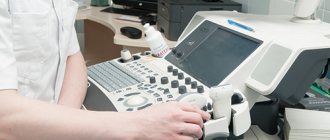Normal female breast anatomy
The mammary gland consists of stroma and parenchyma.
The parenchymal component of the mammary gland is represented by the ducts and acini of the mammary glands. The stromal component is the support of the mammary gland, i.e. its connective tissue, which connects the parenchyma of the mammary gland itself with adipose tissue. The number and distribution of structural components of the mammary gland are strictly individual, depending on the woman’s age and her hormonal status. The parenchymal component of the mammary gland consists of 15-25 lobes, which have their own ducts (milky ducts) flowing into the common space under the nipple. This space is called the milky sinus. Each milk duct is successively divided into segmental, subsegmental and terminal. The terminal ducts empty into the mammary acinus.
Breast tissue has three levels. The first, most superficial, subcutaneous layer consists of fat, organized into lobules, bounded by fibrous septa by Cooper's ligaments. Cooper's ligaments connect the superficial layer to the middle layer. The middle layer is the mammary gland itself, the mammary layer is represented by the parenchymatous component. The deepest, retromammary layer, a derivative of fat lobules, is bounded in front by the deep mammary fascia and behind by the pectoral fascia.
Features of the breast associated with the menstrual cycle
The breast is a hormonally sensitive organ of the female reproductive system. During a normal ovulatory menstrual cycle, the changes that occur in the mammary gland are as follows. In the first, follicular phase of the cycle (days 7-14), minimal structural changes occur. The gland ducts are experiencing the proliferation phase of gland development, the alveoli are closed, and the cellular stroma is dense. In the luteal phase of the cycle (days 16-20), the proliferation of the glands ends, and the glands expand, caused by edema and hyperemia of the alveoli. Normally, during ultrasound of the breast, cyclic changes are faintly noticeable.
Features of the breast associated with pregnancy and breastfeeding
With hormonal changes associated with pregnancy and lactation, rapid development of the parenchyma occurs, namely the ducts and acini of the mammary gland. Due to this, the breasts increase in size and often become more sensitive. This is accompanied by regression of the interlobular stroma, the fat lobules of the subcutaneous and retromammary zone are reduced. Only during breastfeeding does a full cycle of development of all mammary gland structures occur, which is of utmost importance in the prevention of breast cancer. But at this time the mammary gland is especially vulnerable to external factors. Therefore, during breastfeeding, especially at the stages of lactation, minimal external influence is very important. Expression should, if possible, be carried out by the nursing mother herself using a breast pump. Spreading with “alien hands” with “crocodile tears” of a nursing woman causes deep trauma to the breast, negates the value of breastfeeding in the prevention of breast cancer, and even vice versa, increases the risk of developing breast cancer in the future.
Description of the procedure
How is an ultrasound done? To examine the condition of the mammary glands, the patient needs to undress to the waist. The study is carried out in a supine position with arms raised. Applying a special gel to the skin is a quick preparatory step. The substance improves the conductivity of ultrasonic waves. After applying the gel, the doctor begins to diagnose the breast tissue using a sensor. These manipulations are absolutely painless. After the sensor comes into contact with the skin, a graphic image appears on the computer monitor. In general, the procedure takes 15–20 minutes. The patient immediately receives a conclusion in which the condition of the mammary glands is described in detail. The attending physician interprets the results.
Ultrasound of the mammary glands is normal
The most superficial structure visible during ultrasound of the mammary glands is the skin. During ultrasound of the mammary glands, the skin looks like an echogenic uniform zone, 2 mm thick; in the area of the areola, the skin is slightly thicker. Fibrocystic disease (fibrocystic mastopathy) Fat lobules in the subcutaneous and retromammary zones with ultrasound of the mammary glands look like low-echoic structures, penetrated by echogenic lines and dotted loci. Fat lobules have a multifaceted or elliptoid shape. The tissue representing the mammary zone consists of closely associated parenchymal structures and connective tissue. In general, this area on breast ultrasound is hyperechoic with small areas of hypoechoic fatty tissue. On ultrasound of the mammary glands in lactating women, the mammary zone is moderately echogenic with the same inclusions of fat of low echogenicity. Hypoechoic linear branching structures during ultrasound of the mammary glands against the background of the hyperechoic mammary zone of the duct. The normal width of the ducts on ultrasound of the mammary glands is from 1 to 2 mm, they do not have expansions, and can evenly narrow towards the periphery of the mammary gland. The exception is the mammary sinuses, which expand directly in the retromamillary region.
An abnormal picture on breast ultrasound is observed in the presence of benign and malignant breast formations.
How is the procedure done and why?
Ultrasound allows you to evaluate the structure of tissues, identify pathological formations in the stroma of the mammary gland - cysts, fibroadenomas, proliferation of fibrous structures and other neoplasms. If hardware is available, Doppler sonography is performed to measure the speed of blood flow and the lumen of the vessels feeding the gland. A breast examination includes examination of regional lymph nodes. Also, if a tumor is suspected of being malignant, a biopsy is performed under the control of an ultrasound sensor.
A routine breast ultrasound takes place in the ultrasound specialist's office - the patient is undressed to the waist and lies on the couch, lying on his back. During the examination, the doctor examines not only the breast itself, but also the axillary and subclavian lymph nodes. Regional lymph nodes are also called sentinel lymph nodes, because in breast cancer they are often the first to signal a malignant process.
Benign formations on ultrasound of the mammary glands
Benign breast formations are divided into cystic and solid.
Breast cysts are:
- Simple.
- Complex.
- Combined
Often cysts are a component of fibrocystic mastopathy (dysplasia) of the mammary glands. Fibrocystic mastopathy is the most detected condition during ultrasound of the mammary glands in women of reproductive age. The reason for seeking an ultrasound of the mammary glands is most often pain. In case of mastopathy, a characteristic sign of ultrasound of the mammary glands is compaction of the connective tissue, moderate dilation of the ducts of the mammary glands, and the presence of small cysts. These manifestations are completely individual for each woman.
Solid benign formations on ultrasound of the mammary glands:
- Breast fibroadenoma is a benign tumor of the breast.
- Galactocele is a formation associated with the accumulation of secretions from the mammary gland ducts.
- Breast abscess formation of purulent-inflammatory origin. Etc.
When to do a breast ultrasound
Ultrasound of the mammary glands is recommended to be performed on certain days of the menstrual cycle if the woman does not use hormonal contraceptives and is not in menopause. Breast cyst
Cycle days for breast ultrasound from 8 to 14 are the most preferable. If a woman no longer menstruates, or she uses hormonal contraception of any kind, the day of the cycle for performing an ultrasound of the mammary glands does not matter.
Symptoms that require an ultrasound of the mammary glands:
- Pain in the mammary gland, associated or not associated with the menstrual cycle.
- Breast injury.
- Changes in the color, density, appearance of the skin of the breast, the appearance of retracted areas on the mammary gland, including when the nipple is retracted.
- If a lump or lumps are detected during self-examination of the mammary glands.
- Enlargement of one or both mammary glands.
- Enlarged axillary lymph nodes.
- Genetic predisposition to benign or malignant breast formations.
- Detection of gynecological pathology, for example, during ultrasound of the uterus, ultrasound of the ovaries (transvaginal ultrasound), in the presence of cervical dysplasia, cervical erosion. This is due to the fact that the female reproductive organs (uterus, appendages) in their work, as well as the mammary glands, are highly sensitive to hormonal changes and together can demonstrate this clearly in the form of a combined pathology of these organs.
Ductectasia: symptoms
Ductectasia of the mammary glands is a disease with quite pronounced symptoms, which usually include:
- soreness in the chest area;
- seals in the area of the areola, detected upon palpation;
- itching and burning in the nipple area;
- swelling and redness of the nipple tissue;
- retraction of the nipple or its displacement relative to its normal position;
- nipple discharge: considered one of the main symptoms. Normally, the small amount of milk produced by the glands does not reach the nipple. In the case of ectasia, the discharge may vary, from whitish to yellowish and brown, and bloody. The latter require special attention, as they may indicate the possible presence of a tumor.
In the case of a disease such as ectasia, the success of getting rid of it largely depends on the speed of detection of this disease, because it is much easier to treat it in the early stages. That is why, when the first signs of a possible illness or other unpleasant symptoms appear, you should seek advice from a specialist mammologist.
.
Initial appointment
An initial appointment with a specialist involves interviewing and examining the patient: recording complaints, leaving a family history (if necessary), palpating the mammary glands and prescribing additional diagnostic procedures.
Diagnostics
Diagnosis of a disease such as ductectasia is intended not only to differentiate it from other diseases with similar symptoms, but also to find out the reason for the expansion of the canals, because the choice of method to solve the problem will depend on this.
Diagnosis of ectasia includes:
- mammography: allows you to assess the condition of the ducts and the presence of neoplasms (polyps, papillomas or tumors);
- Ultrasound of the mammary glands: provides dynamic, more accurate information about the existing problem;
- smear-imprint of discharge from the nipple: allows you to determine the presence of inflammation, suggest the presence of a neoplasm;
- blood test for hormones: may be prescribed if there is a suspicion of hormonal imbalance;
- biopsy: can also be performed if neoplasms of unknown etiology are detected.
- ductography: this is an x-ray examination of the milk ducts of the mammary gland with the introduction of a contrast agent into them. This method is a type of mammography.
Treatment plan
If the diagnosis confirms the initially assumed diagnosis of ductectasia of one or both mammary glands (bilateral ectasia), the treatment prescribed by a specialist will be aimed at eliminating the manifestations of the disease and the causes of its occurrence.
In most cases, when the ducts are dilated, conservative treatment is indicated, focused on the factors that caused the disease. So, if chronic or acute inflammation was detected during diagnosis, the patient will be prescribed anti-inflammatory drugs, as well as complexes aimed at generally strengthening the immune system.
If the disease is caused by a hormonal factor, the goal of treatment will be to normalize hormonal levels, which is achieved by taking a number of hormonal medications. The set and dosage of such drugs are determined by a specialist based on the patient’s age, her general health, and the presence of concomitant diseases. Taking any hormonal medications is possible only after prior consultation with a doctor.
If conservative treatment does not give the desired results, the problem of dilated milk ducts is solved surgically - especially if we are talking about the presence of papillomas or polyps in the canal.
The operation performed in this case can be of two main types:
- removal of altered areas of milk ducts and epithelial cells. The obtained material is necessarily sent for histological analysis to exclude oncological diseases;
- complete removal of the mammary ducts: usually if there are malignant neoplasms.
In both cases, the operation is usually done under general anesthesia and leaves relatively minimal cosmetic defects. A contraindication to surgery may be a number of concomitant diseases (for example, heart disease) or the patient’s desire to have a child and subsequently breastfeed him. In each specific case, the possibility of surgical intervention or refusal of surgery should be discussed in detail with a specialist - especially if we are talking about suspected malignant neoplasms.
Result
The results of treatment directly depend on the timeliness of diagnosis of the disease and the causes of its occurrence. Most often, the problem can be eliminated, especially if the patient consulted a specialist on time and the examination did not reveal serious complications (primarily malignant tumors).
Prevention
To avoid problems associated with the enlargement of the gland canals, you should adhere to the following preventive measures, since trying to prevent a disease such as ectasia is much easier than treating ductectasia later.
Measures to prevent ectasia include:
- control of hormonal levels, especially prolactin levels: in the case of dilated ducts, this primarily concerns women over 40, however, younger women should also monitor the balance of hormones and use medications with caution that can disrupt this balance;
- reducing the risk of chest injury, as well as the risk of surgery;
- timely and complete treatment of inflammatory processes before they enter the chronic stage; strengthening the immune system with moderate physical activity and taking vitamins (after consultation with a specialist);
- proper hygiene of the breasts and nipples, as well as wearing comfortable underwear that does not injure or deform the breasts;
- proper nutrition, weight control, giving up bad habits (alcohol and smoking in the first place);
- preventive examination by a mammologist
at least once a year with mammography or also at least once a year; it is necessary to be able to conduct an independent examination of the breast in order to be able to detect lumps or neoplasms in time; - If you detect symptoms of possible dilation of the milk ducts (or suspect the presence of a disease), you must make an appointment with a specialist and undergo a full examination.
You can make an appointment at the Energo clinic by phone or through a special patient registration form, which is posted on the medical center’s website. Take care of your beauty and health!
Preparing for breast ultrasound
No special training required. Preventive examination of the mammary glands is carried out in the first phase of the cycle. If the alarming symptoms listed above are detected, an ultrasound of the mammary glands is performed as soon as possible.
Ultrasound of the mammary glands is recommended for all women without exception once a year as a preventive screening. Ultrasound of the mammary glands is an absolutely safe and informative form of diagnosing the condition of the mammary gland and eliminating the risk of breast cancer. The age range for using breast ultrasound to exclude breast cancer is no longer limited to 35-year-old women with the advent of high-resolution equipment with elastography effect and sensitive duplex scanning of blood vessels. Elastography allows for differential diagnosis of formations based on their density and displacement in women of any age. Our clinic has a modern ultrasound scanner with elastography, which allows us to perform ultrasound diagnostics of the mammary glands in the most informative and high-quality manner.
Recommendations for preparing for the procedure
Before diagnosing the mammary glands, a woman can lead her usual lifestyle. Ultrasound does not require any special preparation. The only thing you need to do is take a shower to cleanse the skin in the chest area and muscle cavities. There are no dietary restrictions. When to do an ultrasound? Any time the diagnostic room is open. However, it is important to know which cycle to sign up for the procedure. This information is listed below. The phases of the menstrual cycle cannot be ignored. Hormonal changes in the body can affect the structure of glandular tissues.








